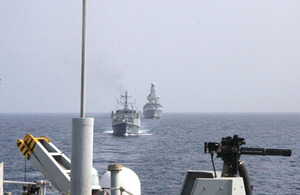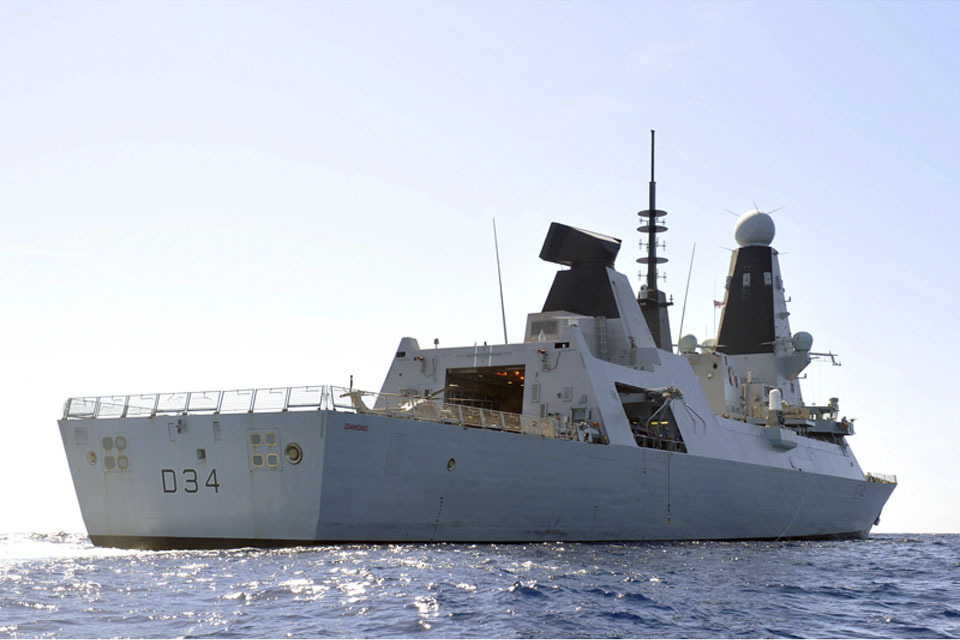UK mine warfare force changeover in the Gulf
It's all change in the Gulf with the arrival of two new ships and two new crews to sustain the Royal Navy's long-term mine warfare force in the region.

HMS Atherstone leads HMS Shoreham and HMS Diamond in the Gulf [Picture: Crown Copyright/MOD 2012]
HMS Atherstone and HMS Shoreham have arrived to replace the outgoing HMS Middleton and HMS Pembroke, whilst the crews of HMS Quorn and HMS Ramsey have traded places with their counterparts in the UK.
After a six-week journey from the UK, the duo have reached the waters which will be their home for the next two to four years.
Britain maintains a constant minehunter presence in Bahrain - four warships, plus a Royal Fleet Auxiliary support ship. Crews are changed every six or seven months, while the ships themselves typically spend three years in the region.
Homeward bound are HMS Pembroke and HMS Middleton, now Atherstone and Shoreham have taken their place.
The passage for the outbound ships - all the while monitoring passing shipping as part of the Royal Navy’s commitment to global maritime security - was relatively calm.
But upon entering the Gulf of Oman, the pair ran into the full force of the south-west monsoon - winds of 40 knots (74km/h) and a five-metre sea swell, conditions known with usual Royal Navy understatement as ‘lumpy’.
In the calmer waters of the United Arab Emirates, the incomers met the outgoers to formally handover duties in the region before Atherstone and Shoreham joined up with Type 45 destroyer HMS Diamond to enter the southern Gulf together.

HMS Diamond pictured en route to the Gulf earlier in her deployment (library image) [Picture: Leading Airman (Photographer) Weatherston, Crown Copyright/MOD 2012]
Once there, the minehunters parted company, with Shoreham making for the Gulf’s most well-known metropolis, Dubai, and Atherstone sailing for Bahrain.
Both are now getting used to the challenges of training in the sandy waters and searing temperatures which are around 40 degrees Celsius (104 degrees Fahrenheit).
The new crews for HMS Quorn and HMS Ramsey have taken charge of the Hunt and Sandown Class vessels respectively in the latest roulement of mine warfare sailors.
Crew 3 of Mine Countermeasures Squadron 2, custodians of HMS Brocklesby for the past two years, are now on board HMS Quorn, while Crew 5 of Mine Countermeasures Squadron 1 have relieved Crew 6 on HMS Ramsey.
For the new incumbents of Ramsey, the Gulf is not a new experience as many served with HMS Grimsby which returned from the area less than 12 months ago.
For the former HMS Brocklesby crew, however, the heat might be a bit of a shock as she has spent the past two years operating around the UK and the Mediterranean.
Despite the Gulf heat, the tempo in the summer does not let up for the mine warfare quartet which carries out a mix of routine survey work, training and international exercises, as well as continuing to build on the UK’s long-standing bond with the various Gulf states.
HMS Quorn’s Commanding Officer, Lieutenant Commander Jim Buck, said:
The deployment’s a great opportunity to show our strengths - and to put into practice all the hard work and training that’s taken place over the past six months.
I’m confident we’ve come into this with the strongest team possible - and are looking forward to the challenges that lie ahead.
The Commanding Officer of HMS Ramsey, Lieutenant Commander Giles Palin, said his ship is prepared for any eventuality:
She remains ready for any task that may come her way.
In between our busy operational programme, the crew will try to find time to enjoy the cultural experiences of the region and, where they can, get ashore to visit the splendid cities and countries of the Middle East.